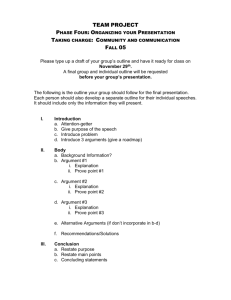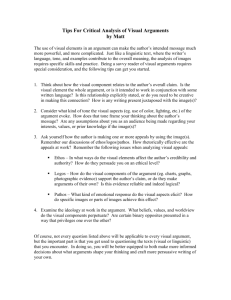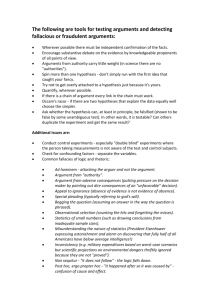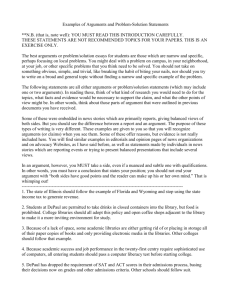1.04.07
advertisement
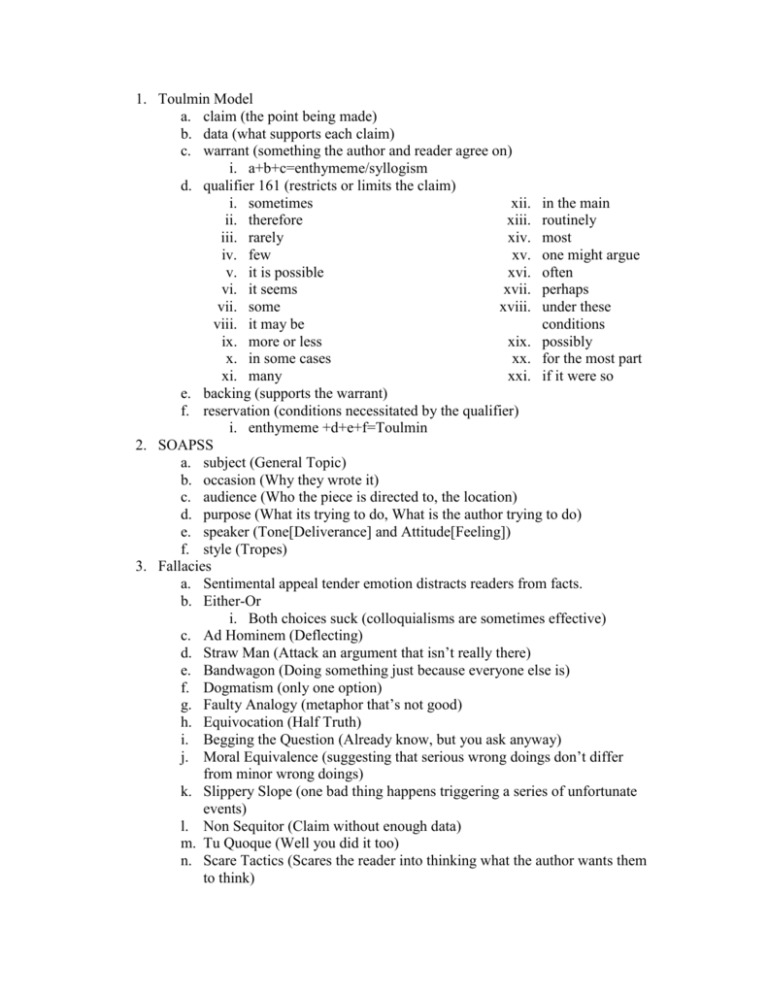
1. Toulmin Model a. claim (the point being made) b. data (what supports each claim) c. warrant (something the author and reader agree on) i. a+b+c=enthymeme/syllogism d. qualifier 161 (restricts or limits the claim) i. sometimes xii. in the main ii. therefore xiii. routinely iii. rarely xiv. most iv. few xv. one might argue v. it is possible xvi. often vi. it seems xvii. perhaps vii. some xviii. under these viii. it may be conditions ix. more or less xix. possibly x. in some cases xx. for the most part xi. many xxi. if it were so e. backing (supports the warrant) f. reservation (conditions necessitated by the qualifier) i. enthymeme +d+e+f=Toulmin 2. SOAPSS a. subject (General Topic) b. occasion (Why they wrote it) c. audience (Who the piece is directed to, the location) d. purpose (What its trying to do, What is the author trying to do) e. speaker (Tone[Deliverance] and Attitude[Feeling]) f. style (Tropes) 3. Fallacies a. Sentimental appeal tender emotion distracts readers from facts. b. Either-Or i. Both choices suck (colloquialisms are sometimes effective) c. Ad Hominem (Deflecting) d. Straw Man (Attack an argument that isn’t really there) e. Bandwagon (Doing something just because everyone else is) f. Dogmatism (only one option) g. Faulty Analogy (metaphor that’s not good) h. Equivocation (Half Truth) i. Begging the Question (Already know, but you ask anyway) j. Moral Equivalence (suggesting that serious wrong doings don’t differ from minor wrong doings) k. Slippery Slope (one bad thing happens triggering a series of unfortunate events) l. Non Sequitor (Claim without enough data) m. Tu Quoque (Well you did it too) n. Scare Tactics (Scares the reader into thinking what the author wants them to think) o. False Authority (What I say must be true) p. Faulty Causality (Post hoc ergo proctor hoc) q. Hasty Generalization (Stereotypes) 4. Tropes a. Figures of speech b. Hyperbole (exaggeration) c. Metaphor (comparison between 2 things) d. Similes (comparison using like or as) e. Analogy (draws comparison between 2 things) f. Signifying (cleverly and often needles the listener) g. Understatement (quiet muted message) h. Irony (verse used to convey opposite meaning) i. Scheme (adds syntax) j. Antonomasia (word or phrase to describe a person) k. Rhetorical questions (Doesn’t require an answer.) 5. Syllogism a. 3 parts – Major Premise, Minor Premise, Conclusion 6. Enthymeme a. 3 Parts – Same as above, but can be argued 7. Goals a. Intermediate i. i.e. grades b. Ultimate i. Graduate valedictorian 8. Rhetoric a. Pathos i. Heart 1. Picture, cry b. Ethos i. Authority 1. Doctor c. Logos i. Facts and Statistics 9. Structured Arguments a. Make it clear b. Persuasive points 10. Satire a. Expose something in an ironic way 11. Thesis Statement: 3 What’s and So What a. 3 reasons of the subject b. So What is what is significant 12. Ways We Lie – Stephanie Ericsson (Nov. 5) a. White Lie (Moral Equivalence) b. Facades (Faulty Analogy) c. Ignoring the Plain Facts (Faulty Causality) d. Deflecting (Ad Hominem) e. Omission (False Authority) f. Stereotypes and Cliches (Equivocation) g. Groupthink (Bandwagon) h. Out and Out Lies (Slippery Slope) i. Dismissal (False Authority) j. Delusion (Moral Equivalence) 13. Syntax a. Specific word choice 14. Diction a. Order you write the words 15. Rogerian Argument a. An argument that attempts to find common ground as opposed to proving your point. b. Not either/or 16. Cartesian Graph a. Charts: characters life, nadir, apex b. X axis- Time c. Y axis- Intangible 17. Claims a. Claim of policy- Call to action b. Claim of definition- Explains what something means c. Claim of value- Judges what is desired and what is not d. Claim of cause- Suggests before and after relationship 18. Deductive Reasoning a. Moves from the general to the particular 19. Inductive Reasoning a. Moves from the particular to the general b. Sun rose yesterday, Sun rose today, so the sun will rise tomorrow 20. Tone a. Speaker or writers attitude towards the subject (Tonto Alexi Sarcastically whimsical) 21. Cognitive Dissonance a. When we encounter an argument we disagree with :] </3 = :[ 22. Purposes argument a. Argument to convince (Persuade the reader rather than fight the opponent.) b. Argument to explore (The writer’s assertion that something exists.) c. Argument to make decisions (Using arguments to explore and arguments to convince and putting them together.) d. Argument to meditate or pray (Hoping to convince the audience to reach a state of equilibrium) e. Argument to inform (To inform the audience of something they did not know) 23. Occasions of argument. a. Past (Debate what happens in the past using forensic evidence.) b. Present (Arguments of contemporary values in society. Moral Equivalence.) c. Future (Deliberative arguments. Debates what should or will happen in the future.) 24. Schemes a. Parallelism (Use of grammatically similar phrases or clauses for special affect.) b. Antithesis (Use of parallel structures to mark contrast or opposition) c. Inverted Word Order (Parts of a sentence or clause that aren’t in the usual subject-verb-object order and help make arguments particularly memorable) d. Anaphora (Effective repetition can act like a drum beat in an argument. Brings the point home) e. Reversed Structures (For special effect have been used in political arguments.) 25. Hard Evidence a. Support for arguments using facts and statistics or other finds b. See forensic evidence 26. First Hand Evidence a. Observations, questionnaires, surveys, experience and experiments b. Think of first person 27. Persuasive Evidence a. Should match time and place of argument 28. Types of Presentations a. Print i. Most effective ii. Tone and purpose iii. Format b. Oral/Multimedia i. Needs ii. Values iii. Structural style iv. Visual aid v. Practice c. Web Based 29. Thinking Rhetorically a. STAR – sufficient, typical, accurate, relevant 30. Vocabulary 31. Rhetorical Triangle a. Topic/Message – Logos b. Bottom Left/Audience-Pathos c. Bottom Right/Speaker and Writer-Ethos 32. Quantitative Data a. Numbers 33. Qualitative Data a. Characteristics 34. Rewriting the Question 35. Argument is to discover the truth; persuasion is to know the truth. 36. Coming clean about motives, who’s interest are they serving, how will they profit from the proposal. 37. Claiming authority- what does he know about the subject and what experiences does he have that make him knowledgeable (ethos). 38. Types of evidence, facts, testimonies, interviews, statistics, surveys, narratives and polls. 39. Second hand evidence is library sources and online sources. 40. Observations are to record what is happening and make sure it relates to your argument. 41. Establishing credibility. Make reasonable claims and back them up with evidence and documentations (ethos). 42. Invitational arguments, not directed a person, to win over a person or a group. 43. Levels of diction non standard informal and formal.



